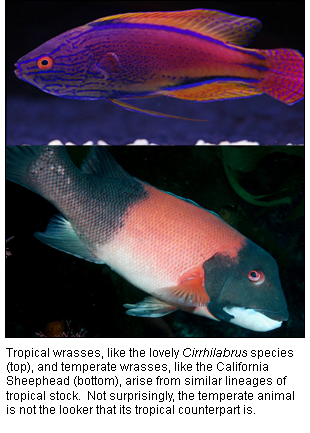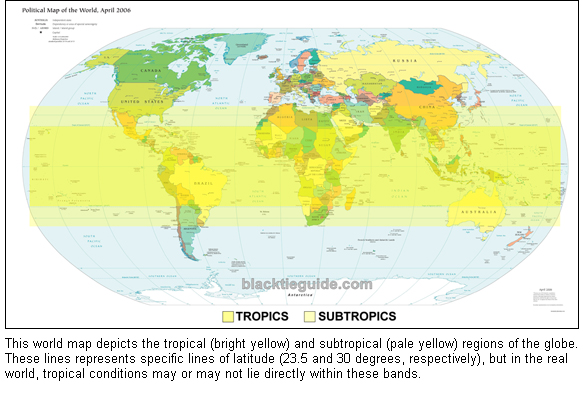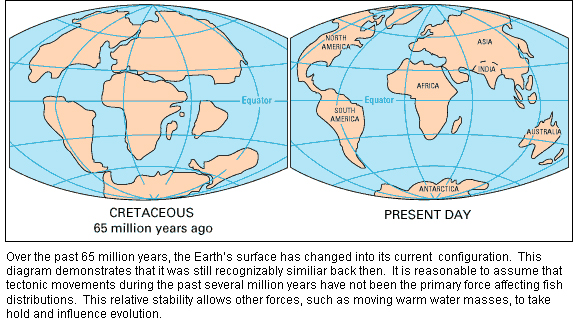Tropical Roots


Introduction:
Life on the reef has oh so many twists and turns. There are so many diverse goings on, so much competition, and a general extravagance that is just not in any other aquatic environment. Tropical fish, in particular, have tended to adopt an extreme degree of flamboyance in terms of body shape and coloration. Though we may not know what all of this flamboyance means, it is clear that it is important or else it would not be there at all. Take temperate fishesthey have more demure colors, fewer body morphs, and are generally less spectacular looking. They owe their rather homely appearances to a relatively lesser degree of competition than that which exists in the tropics. However, it is the relative origins of these groups of fishes that are the truly interesting aspects. For the most part, temperate fishes evolved from tropical fishes that share the same approximate line of longitude. That is, over time equatorial fishes have moved north and south, and taken up permanent residence. Thats right, most familiar species of nearshore fishes have ancestral origins in the tropics, and it is all due to the vagaries of life on the reef.
Most people, especially marine aquarists, have a sense of what are the tropics. Palm trees, white sand, and clear waters with coral reefs and tropical fish. While this characterizes the tropics in some senses, those attributes are really just reflective of Earths processes at or near the equator. Since the planets wobble is less profound at the equator, seasonality is greatly reduced. Equatorial environments, especially marine, tend to stay stable for long periods of time. The tropics, by definition, occur in the band within 23.5 degrees of the equator. These lines are demarcated by the Tropic of Cancer in the north and the Tropic of Capricorn in the south, however tropical conditions can occur as far from the equator as 30 degrees. Furthermore, environmental fluctuations on a yearly or decadal scale cause regular expansions and contractions of warm water into more temperate regions.
So what is it that is so special about tropical fish, and why has their stock more greatly influenced temperate stocks than vice-versa? The answer is clearly competition. Loosely defined, competition is the struggle for an ecosystems resources in the context of food, space, and mates. It can occur both amongst conspecifics and between heterospecifics, and so connotes a vast number of diverse competitive interactions. Some of this competition is overt, such as fighting for food or growing into empty spaces. Other competition is less conspicuous, like using the same resource at a different time of day than anyone else. In whatever form it comes, competition is surely a driving force in natural selection, and by extension, evolution.
Competition on the Reef:
On tropical reefs, competition is extremely fierce, for two primary reasons: a) Food is limited, and b) So is space. Though healthy tropical waters may be teeming with life, it is only that way because of the tenacity of living organisms to persist against all odds. Just the probability of recruiting to a population is astronomical for a larval fish or invertebrate, let alone surviving to adulthood. Food is scarce because the waters are generally starved of nutrients. What little exists is quickly taken up by invertebrates and algae. These organisms are the base of the food web, and their own food sources are in short supply. In turn, larger predators such as fish have been forced to diversify their approach to nutrition. Tropical fish can be carnivores, omnivores, herbivores, or even coprophages (look that one up). There are fish with small mouths and long snouts, and ones with large mouths and small snouts. Some fish graze in large schools, while other defend a small territory of their own. There are even many fish that make a living by eating parasites off of larger fish and turtles. Some fish are small and colorful while others are large and silvery, and vice-versa. All of the adaptations, along with many others, are coping mechanisms these species have used to survive the eons of evolutionary time. Many fish have evolved to utilize a singular tiny ecological niche that allows them to persist, and they have specialized in a way that can only be caused by severe competitive pressures.

Competition Poleward:
By contrast, temperate fish do not have to compete with each other in the manner that is true of their tropical counterparts. Temperate waters, which basically occur between the tropics and the Arctic and Antarctic circles, tend to be highly productive when nearshore. Nearshore waters are usually subject to nutrient rich run-off. The waters may also be enriched by upwelling, such as the kind that occurs off the coast of California. Such circumstances lead to microalgal blooms that eventually go on to form the regional food webs. Because these blooms can be very pervasive, the primary production they represent is essentially limitless as it enters the ecosystem. The micro- and macro-invertebrates populations that feed on this limitless food supply are themselves virtually limitless in their ability to feed higher-level organisms such as fish. Basically, food is equally available for every fish in a temperate community. As such, fish move toward a general approach of carnivory, and most temperate species reflect this change. Herbivory and coprophagy are virtually non-existent in many temperate regions, because digesting plant-like materials is difficult for vertebrate animals. Since meat is readily available to all, it has evolved to be the staple for the vast majority of these fish species. In temperate waters, the lack of competition alleviated the evolutionary pressure to diversify the approach toward obtaining food. Furthermore, less restrictive habitat associations exist in temperate waters, and fish morphology has also not been forced to change in the manner of tropical species.

Tropical Invasion:
The diversity demonstrated in tropical fish has allowed them to quickly find ways to exploit new environments. Whenever warm water masses expanded or relocated, new habitat areas were exposed to tropical fish. The regime of constant competition forced fish to quickly move into new areas before anyone else did. In a way, it is like a landgrab. However, when the warm water recedes, only certain individuals are able to persist. These individuals go on to start new populations of slightly different fish. Over geological time this kind of thing has occurred millions of times, causing a slow seepage of tropical fish into temperate waters. Many types of tropical fishes, such as wrasses, gobies, damsels, and tunas have all made the leap from tropics to cold temperate waters.
Fascinatingly, temperate fishes are often ancestral allies with fish from tropics that occur along the same line of longitude. What happens, in a nutshell, is that water temperatures stay fairly consistent along the equatorial band (and have throughout geological time). The only directions in which warm water can expand or contract are poleward. Therefore when new habitat areas are open to a fish species, it is generally directly south or northward. Scientific evidence bears this assertion out; many temperate species are directly descended from tropical fish that occur immediately to the equatorial side of their ranges. Moreover, the process rarely occurs in reverse. Tropical fish have been able to radiate so well because they have variation veritably written into their DNA. What suits one tropical fish will not necessarily suit another, whereas temperate fishes really do not care as much. While there are many general groups of tropical fishes, there are relatively few groups of temperate fishes. This differential is what has lead to the expansion of tropical species into temperate waters, and not vice-versa. Think of it this way: if you throw a group of five different yellow darts at the wall, or a group of one hundred different green ones, which color will have more darts stick?
Of course, many other events have impacted the distribution of fish on Earth, not the least of which are geological processes. The tectonic movements of the planets crust have reshaped the Earth many times over, and in so doing have often dramatically changed the course of evolution. However, a rough approximation of the current conditions have existed for tens of millions of years, which has been more than long enough for the processes explained in this article to have taken precedence.
The End:
It is amazing to think that so many familiar temperate fish species are so intimately linked to the ones we keep in our home aquaria. It might seem like they are completely unrelated; one set unimpressive in its homely appearance, the other garbed in extravagance. If anything, it might be tempting to think that the less ornate evolved to become more so, not the other way around. In fact, it is just the opposite. The spectacular nature of tropical fish is an evolutionary adaptation to extreme competition, while temperate fish just dont need to try that hard. It is like being single or being married. When you are single, you want to dress to impress and look your best everyday. When you are married, you can look in the closet and think, Yeah, sweat pants will work just fine today. Different responses to different pressures.

Works Cited:
Hobson, E.S. Evolution. The Ecology of Marine Fishes, California and Adjacent Waters. University of California Press: Berkeley. 2006. pp. 55-80.